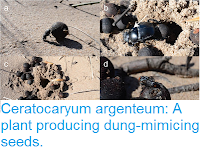A total of 323 Reindeer, Rangifer tarandus, were killed by a lightning strike during a thunder storm on the Hardanangervidda National Park on Friday 26 August 2016.
The Reindeer migrate across the park, which is a mountainous plateau,
at this time of year, and are believed to have huddled together during
the storm, an action which helps to protect the younger members of the
herd (which included 70 calves) from the worst of the elements, but
which makes them particularly vulnerable to (rare) lightning strikes. While tragic for the Reindeer, this event provided a unique opportunity to study the impact of large cadavers on a (nutrient poor) tundra environment.
Reindeer killed by lightning on the Hardangervidda Plateau on 26 August 2016. Håvard Kjøntvedt/Norwegian Environment Agency.
In a paper published in the journal Biology Letters on 15 August 2018, Sam Steyaert of the Department of Natural Sciences and Environmental Health at the University of South-Eastern Norway, and the Faculty of Environmental Sciences and Natural Resource Management at the Norwegian University of Life Sciences, Shane Frank, also of the Department of Natural Sciences and Environmental Health at the University of South-Eastern Norway, Stefano Puliti, also of the Faculty of Environmental Sciences and Natural Resource Management at the Norwegian University of Life Sciences, and of the Norwegian Institute of Bioeconomy Research, Rudy Badia, again of the Faculty of Environmental Sciences and Natural Resource Management at the Norwegian University of Life Sciences, Mie Arnberg, again of the Department of Natural Sciences and Environmental Health at the University of South-Eastern Norway, Jack Beardsley of the Surveying and Spatial Sciences Group at the University of Tasmania, Asle Økelsrud, once again of the Department of Natural Sciences and Environmental Health at the University of South-Eastern Norway, and Rakel Blaalid of the Norwegian Institute for Nature Research, describe the results of a study which monitored the site of the 2016 mass Reindeer site for seeds introduced by scavengers, as a way of demonstrating that endozoochory (seed dispersal via ingestion by vertebrate animals) provides a viable means for plants to reach a new nutrient source within an otherwise nutrient poor environment.
The vegetation at the sire of the study was dominated by Dwarf Birch, Betula nana, as well as Heathers, Grasses, and an understory of Mosses and Lichens. A range of Mammals and Birds were seen scavenging at the site, including Corvids (Raven, Corvus corax, and Hooded Crow, Corvus cornix), Golden Eagle (Aquila chrysaetos), Foxes (Red Fox, Vulpes vulpes, and Arctic Fox, Vulpes lagopus), Wolverine (Gulo gulo) and several Rodents (Arvicolidae). In addition a number of small Birds were observed feeding on Blowflies (Calliphoridae) attracted to the carrion.
Steyaert et al. searched the site for feces of mesopredators, Birds and Rodents, finding a particular corelation between Bird feces and carcass density (i.e. there was more Bird erces in areas where the carcasses were most dense). They then examined the Bird feces for seeds of the Crowberry, Empetrum nigrum, keystone species of the alpine tundra with predominantly vegetative reproduction, finding 87.5% of the feces sampled contained viable seeds.
See also...
Steyaert et al. searched the site for feces of mesopredators, Birds and Rodents, finding a particular corelation between Bird feces and carcass density (i.e. there was more Bird erces in areas where the carcasses were most dense). They then examined the Bird feces for seeds of the Crowberry, Empetrum nigrum, keystone species of the alpine tundra with predominantly vegetative reproduction, finding 87.5% of the feces sampled contained viable seeds.
The Crowberry, Empetrum nigrum, an Arctic keystone species shown to be distributed to sites with carrion by scavenging Birds. Wikimedia Commons.
See also...
Follow Sciency Thoughts on
Facebook.








